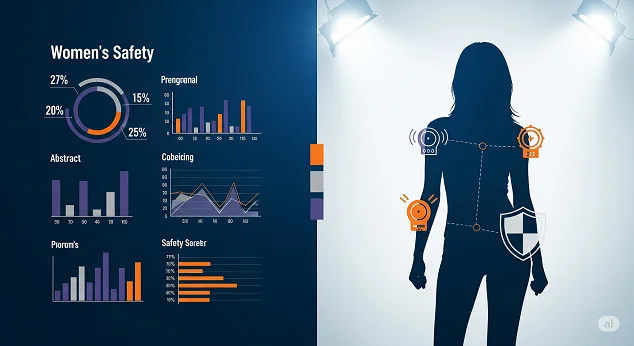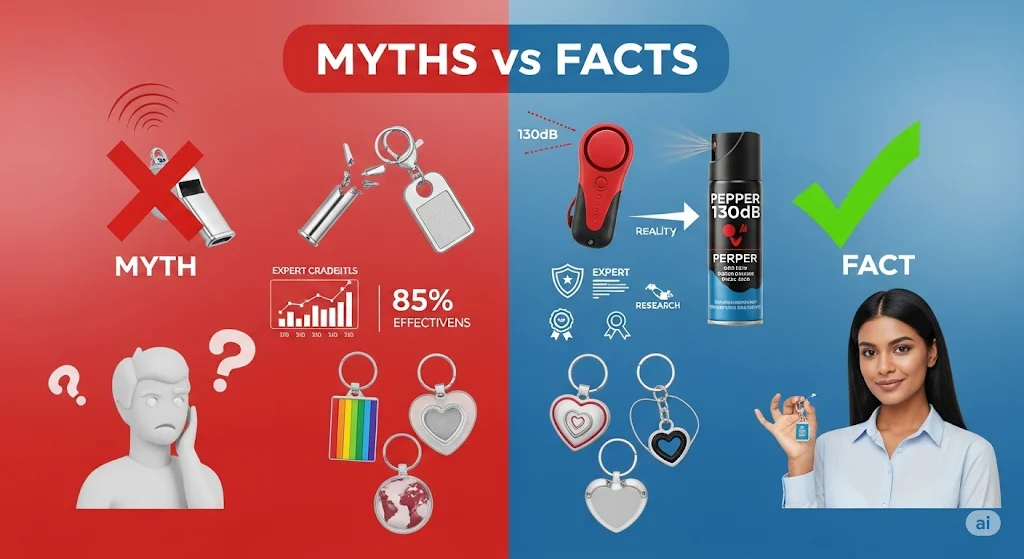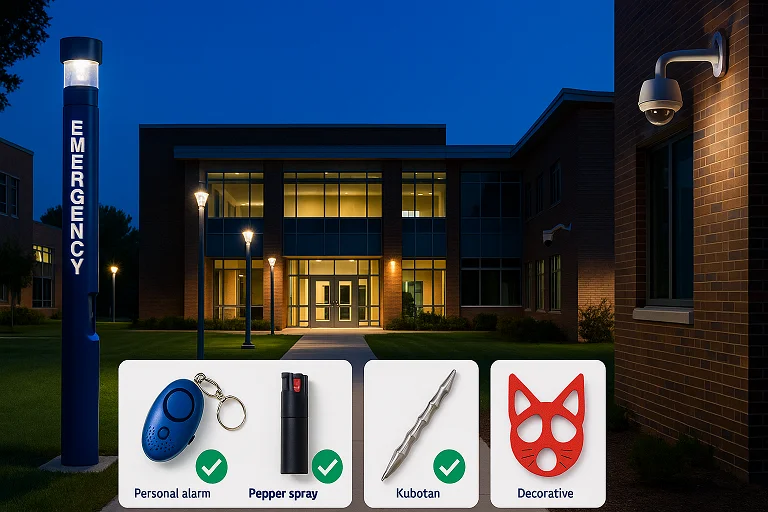Why Women Prioritize Personal Safety—Key U.S. Crime Stats
Data-backed look at victimization rates & why smart gadgets matter more than ever. Complete 2025 analysis of female crime statistics and safety tech trends.

Why Women Prioritize Personal Safety—Key U.S. Crime Stats
It's a calculation many women make every day without a second thought. Which side of the street is better lit? Should I move my car closer? Is it safe to wear headphones on this walk? This constant, low-level hum of risk assessment isn't paranoia—it's a rational response rooted in statistical reality.
This comprehensive guide analyzes the latest U.S. crime data to understand why women face disproportionate safety risks and how data-driven personal protection has become essential. We'll examine victimization rates, explore the psychology behind safety fears, and reveal why smart safety gadgets are experiencing unprecedented market growth.
Important Safety Disclaimer: This article discusses topics of violence and assault that may be distressing to some readers. All statistics are for informational purposes, sourced from national U.S. organizations including BJS, CDC, and FBI. Always consult local law enforcement for area-specific safety guidance.
What You Need to Know About Women's Safety Statistics
Snapshot 2025: Female violent-crime rates have fallen over 30 years, yet women still face double the fear factor of men, lifetime abuse rates above 40%, and a stalking rate 2× higher than males. Smart personal-safety gadgets—from 130 dB alarms to GPS trackers—are booming toward a USD 56B market because the data keep reminding us why peace-of-mind tech matters.
The Bureau of Justice Statistics' National Crime Victimization Survey (NCVS) provides the most comprehensive picture of crime victimization in America. Recent 2023 data reveals that understanding these statistics is crucial for making informed personal safety decisions and choosing appropriate protection tools.
Key points covered in this comprehensive analysis:
- Current violent crime victimization rates by gender from 2023 NCVS data
- Lifetime risk patterns for sexual violence, stalking, and intimate partner violence
- Campus-specific vulnerabilities and safety challenges for female students
- The psychology behind the fear-reality gap and its impact on daily behavior
Current State of Women's Safety in 2024-2025
The landscape of women's safety has evolved significantly with technological advances and changing threat patterns. While overall violent crime has decreased since the 1990s, women continue to face specific vulnerabilities that drive the $56.4 billion personal safety device market projected for 2025.
Recent developments include enhanced GPS tracking capabilities, TSA-approved travel safety tools, and campus safety apps that provide real-time emergency response. Understanding current statistics helps inform both individual safety choices and broader policy decisions affecting women's protection.
Violent Crime Data: The Statistical Reality
The Bureau of Justice Statistics' National Crime Victimization Survey (NCVS) provides the most comprehensive picture of crime victimization in America. Here's what the 2023 data reveals:
2023 NCVS Victimization Rates
| Sex | Violent victimizations reported to police / 1,000 | Change vs. 2022 |
|---|---|---|
| Female | 10.6 | no significant change |
| Male | 9.5 | ↓ (slight decrease) |
Source: BJS Criminal Victimization 2023, Table 5
Key Statistical Findings:
- 6.4 million violent victimizations against women were reported in 2023
- Intimate partner violence (IPV) fell from 3.4 → 2.2 per 1,000 in 2023 but remains female-dominated
- Despite overall crime decreases since the 1990s, women still report slightly higher victimization rates
- Female victims are more likely to report crimes to police compared to male victims
This data underscores why effective personal safety tools like 130 dB alarms remain essential for women's daily protection and why understanding proper usage can be life-saving.
Lifetime Risk Patterns and Abuse Statistics
The lifetime statistics paint an even starker picture of cumulative risk:
Sexual Violence & Assault:
- 41% of U.S. women have experienced contact sexual violence, physical violence or stalking by a partner
- 26.8% of women have suffered completed or attempted rape during their lifetime
- 80% of rape/sexual assault cases against women are perpetrated by men
- 57% of cases involve someone the victim knows
Stalking: The Hidden Crime:
- 1.8% of women (vs. 0.8% men) were stalked in a single year—3.4 million victims in 2019 alone
- 67% of female stalking victims are targeted by men
- Only 41% of stalking cases are reported to police
Fatal Outcomes: FBI expanded-homicide data reveals a chilling pattern:
- ≈37% of female murder victims are killed by a current or former boyfriend/husband
- CDC's National Violent Death Reporting System confirms that intimate-partner circumstances precipitate "a large proportion of homicides among females"
These statistics explain why women often choose versatile self-defense tools that can handle multiple threat scenarios, rather than single-purpose items.
💡 Expert Insight: The high percentage of known-offender cases (57%) demonstrates why personal safety tools must be immediately accessible and easy to deploy, even in seemingly safe situations.
Campus and Educational Environment Vulnerabilities
Educational environments present unique challenges that require specialized safety approaches. Current data shows concerning trends that affect female students disproportionately.
Step-by-Step Campus Safety Risk Assessment
-
Understand the Statistical Landscape - 2022 Clery Act data shows 10,400 forcible sex offenses = 44% of all reported campus crimes, with female students accounting for ≈9 in 10 sexual-offense victims
-
Identify High-Risk Environments - Dormitories, libraries, parking areas, and social gatherings require specialized safety approaches for college women with tools that work in academic settings
-
Recognize Vulnerability Patterns - Young women transitioning to independence need comprehensive safety education and tools that work in multiple campus environments
-
Implement Multi-Layer Protection - Campus environments benefit from combination approaches including personal alarms, safety apps, and emergency communication systems
Best Practices for Educational Safety
Campus-Specific Considerations:
- Personal Alarm Selection - Choose devices that comply with dormitory regulations and can be heard across campus distances
- Communication Protocols - Establish check-in systems with trusted contacts and utilize campus safety escort services
- Environmental Awareness - Map safe routes, identify emergency call boxes, and understand campus security response procedures
Legal and Policy Considerations:
- Title IX Protections - Understanding reporting procedures and support services available through educational institutions
- Campus Carry Laws - Knowing state-specific regulations regarding self-defense tools on educational property
The Psychology of Safety: Fear vs. Reality Gap
Perhaps most telling is the disconnect between perception and statistical trends, which drives significant behavioral changes and market demand for safety products.
Fear Statistics and Behavioral Impact
Gallup 2023 Safety Perceptions:
- 53% of women feel unsafe walking alone at night in their area
- Only 26% of men report the same fear
- 66% of women (Pew Research) avoid certain areas near home after dark
Behavioral Consequences: Women are statistically less likely to:
- Jog alone after dark
- Talk to strangers in public
- Attend crowded events due to safety concerns
- Walk through parking garages alone
- Use rideshare services late at night
This fear-reality gap explains why personal safety tools have evolved beyond basic protection to include psychological reassurance—knowing you have options can restore confidence in daily activities.
Market Response: The Rise of Safety Technology
The statistics have driven massive market innovation and investment:
Market Growth Projections:
- U.S. smart personal-safety & security device market forecast: USD 56.4B in 2025
- 11% CAGR projected through 2030
- "Less-lethal" consumer weapons segment topped USD 1B in 2023
Female-Focused Innovation Examples:
- Women represent the core buyer demographic for personal safety devices
- Products like the Birdie 130 dB alarm—designed by two sisters—sold 1 million units since 2022
- TSA-friendly travel safety gear has become a billion-dollar subcategory specifically addressing female traveler concerns
Evidence-Based Product Selection Guide
The statistics reveal why different tools address different threat patterns, allowing for strategic safety planning:
For Stalking & Harassment Prevention
130 dB personal alarms disrupt the stalker's core advantage: secrecy and control. The instant, piercing sound transforms a private intimidation into a public emergency.
Recommended Products:
- Black And White Cow Self Defense Keychain Set - Complete 15-piece protection system with 130dB alarm, pepper spray, and tactical tools
- Green Flower Personal Safety Keychain Set - Discreet yet powerful alarm system perfect for daily carry
For Physical Assault Prevention
Pepper spray and kubotans create the escape window that violent crime statistics demand. When 37% of female homicides involve intimate partners, having tools that work from a distance becomes life-saving.
Recommended Products:
- Rainbow Zebra 15 PCS Self Defense Keychain Set - Multi-tool approach for varied threats including pepper spray, tactical pen, and emergency whistle
- Red Heart 13 PCS Self Defense Keychain Set With Crossbody - Wearable protection with crossbody convenience for hands-free carry
For Travel & Campus Safety
The 44% of campus crimes being sexual offenses, combined with solo travel vulnerabilities, requires comprehensive kits that work in multiple environments and comply with various regulations.
Recommended Products:
- Jewelz Ocean 16 PCS Self Defense Keychain Set - Complete travel-ready protection with TSA-compliant components
Legal Framework and Self-Defense Rights
Understanding your rights is crucial when carrying protection tools. The legal landscape varies significantly by state, and it's essential to know current self-defense laws and regulations before choosing your safety toolkit.
Federal Guidelines and Regulations
National Standards:
- TSA regulations for air travel safety tools
- Interstate commerce laws for shipping protection devices
- Federal definitions of "reasonable force" in self-defense situations
State-Level Variations:
- Pepper spray legality and concentration limits (varies from 10% to 18% OC)
- Kubotan and tactical pen restrictions in certain jurisdictions
- Campus-specific regulations for students and staff
Building Your Evidence-Based Safety Strategy
The data points to a multi-layered approach that addresses the variety of threats women face:
Layer 1: Awareness and Avoidance
- 53% fear factor among women validates the importance of situational awareness
- Trust your instincts—they're backed by legitimate statistical risks
Layer 2: Deterrent Tools
- 130 dB alarms for stalking and harassment scenarios (1.8% annual rate)
- Visible safety tools that make attackers choose easier targets
Layer 3: Active Defense
- Pepper spray for the 10.6 per 1,000 violent victimization rate
- Multi-tool kits for the variety of threats women face
Layer 4: Emergency Response
- GPS tracking and emergency apps for the 41% of cases involving known attackers
- Rapid alert systems for campus and workplace environments
Expert Recommendations Based on Current Data
Based on current research and statistical analysis of victimization patterns, security experts recommend:
✅ Comprehensive Protection Kits - Rather than single tools, choose multi-component sets that address stalking (alarms), physical threats (pepper spray), and emergency situations (whistles, flashlights)
✅ Regular Training and Practice - Understanding how to deploy your tools effectively multiplies their protective value and reduces response time in crisis situations
✅ Situational Adaptation - Different environments require different tools—campus, workplace, travel, and home each present unique safety challenges
✅ Legal Compliance Review - Stay informed about local regulations and ensure your safety tools comply with applicable laws
❌ What to Avoid:
- Single-Purpose Tools - The variety of threats women face requires versatile protection options
- Unproven Technologies - Stick with established safety devices with documented effectiveness rates
Current Trends and Statistical Updates
Recent developments in women's safety include:
- Smart Integration: Personal safety devices increasingly integrate with smartphones for GPS tracking and emergency alerts
- Legal Evolution: More states are recognizing women's right to carry appropriate self-defense tools
- Campus Innovation: Universities are implementing comprehensive safety apps and blue-light emergency systems
Conclusion: Your Complete Women's Safety Statistics Guide
The data tells a compelling story about why women prioritize personal safety and why this prioritization is both rational and necessary. While violent crime rates have decreased overall, women continue to face specific, documented risks that require proactive responses.
Here are the essential takeaways from this comprehensive statistical analysis:
- Evidence-Based Fear - The 53% of women who feel unsafe aren't being paranoid; they're responding to documented 10.6 per 1,000 victimization rates
- Known-Offender Reality - With 57% of cases involving someone the victim knows, safety tools must be immediately accessible
- Stalking Underreporting - Only 41% of stalking cases are reported, making personal deterrent tools crucial
- Campus Vulnerability - 44% of campus crimes are sexual offenses, requiring specialized safety approaches for students
- Market Validation - The $56.4B safety device market growth reflects genuine, documented need rather than manufactured fear
The statistics are clear: women face disproportionate risks that require proactive responses. But these numbers shouldn't inspire fear—they should inspire preparation and empowerment through evidence-based safety planning.
Ready to turn statistics into personal safety? Understanding the data is the first step toward building an effective, comprehensive protection strategy that addresses your specific risk profile and lifestyle needs.
**Take Action Based on Data:** The statistics show the reality—now it's time for informed action. Explore our curated **women's safety keychain collections** designed by experts, for women, based on real-world threat analysis and current crime data.Sources & References
- BJS Criminal Victimization 2023 - Bureau of Justice Statistics comprehensive tables & summary analysis
- CDC NISVS 2023 - National Intimate Partner and Sexual Violence Survey & IPV fact sheets
- BJS Stalking Victimization 2019 - Most recent comprehensive stalking data analysis
- Gallup Personal Safety Fears 2023 - National polling on safety perceptions and behavioral impact
- Pew Research Safety & Neighborhood Trust 2023 - Community safety analysis and demographic breakdown
- NCES Campus Crime Fast Facts 2024 - Educational crime statistics and Clery Act compliance data
- FBI Expanded Homicide Data 2023 - Murder circumstances and victim-offender relationships
- CDC NVDRS 2024 - National Violent Death Reporting System bulletin and trend analysis
- Research Nester Smart Safety Device Market 2025 - Industry growth projections and consumer behavior analysis
- National Crime Victimization Survey (NCVS) 2023 - Annual victimization trends and methodology
Last updated: January 2025. Information is subject to change. Always verify current local laws and safety recommendations with appropriate authorities.
Related Articles

The Ultimate Safety-First Gift Guide for Mother's Day 2025
Surprise mom with stylish self-defense gifts that show you care about her security and confidence. Unique Mother's Day gift ideas beyond flowers and chocolates.

5 Myths About Self-Defense Keychains—Debunked by Experts
We bust common objections—from 'they're useless' to 'they look scary'—with facts & training tips. Expert analysis of self-defense keychain effectiveness and safety.

10 Real-World Safety Tips for College Women Walking at Night
Stay confident on campus: practical habits and the must-have keychain tools that protect you after dark. Expert college safety tips for women students.